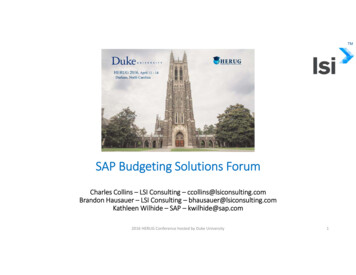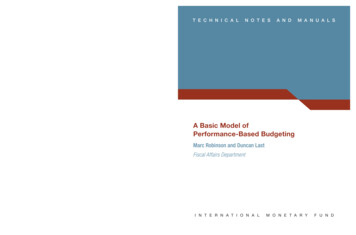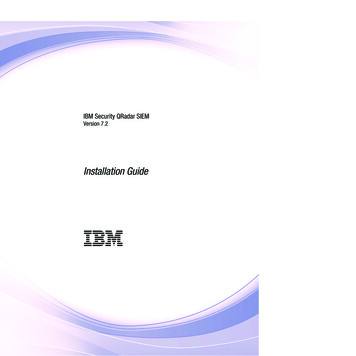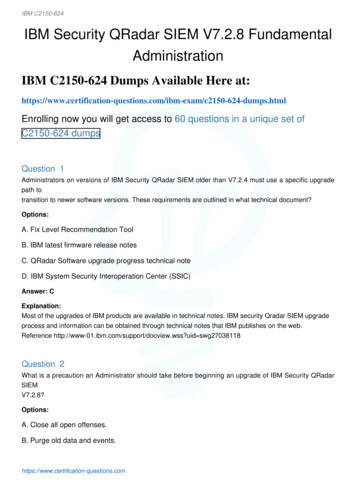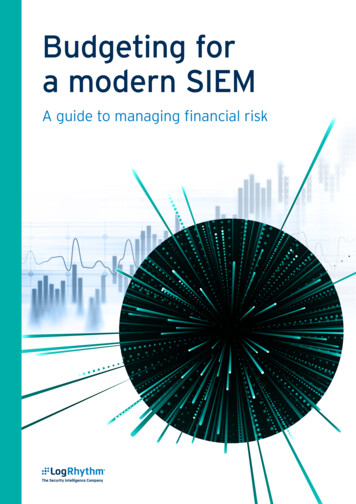
Transcription
Budgeting fora modern SIEMA guide to managing financial risk
TABLE OF CONTENTSIntroduction . . . . . . . . . . . . . . . . . . . . . . . . . . . . . . . . . . . . . . . . . . . . . . . . . . . . . . . . . . . . . . . . 3The relationship between business growth and security . . . . . . . . . . . . . . . . . . . . . . . . . . . 4Increased headcount . . . . . . . . . . . . . . . . . . . . . . . . . . . . . . . . . . . . . . . . . . . . . . . . . . . . . . . . . . . . . . . . . . . . . . . . . . . . .Infrastructure growth . . . . . . . . . . . . . . . . . . . . . . . . . . . . . . . . . . . . . . . . . . . . . . . . . . . . . . . . . . . . . . . . . . . . . . . . . . . .Increased revenue . . . . . . . . . . . . . . . . . . . . . . . . . . . . . . . . . . . . . . . . . . . . . . . . . . . . . . . . . . . . . . . . . . . . . . . . . . . . . . .The modernisation of IT . . . . . . . . . . . . . . . . . . . . . . . . . . . . . . . . . . . . . . . . . . . . . . . . . . . . . . . . . . . . . . . . . . . . . . . . . .4556The risk of business growth . . . . . . . . . . . . . . . . . . . . . . . . . . . . . . . . . . . . . . . . . . . . . . . . . . . 7Security risks . . . . . . . . . . . . . . . . . . . . . . . . . . . . . . . . . . . . . . . . . . . . . . . . . . . . . . . . . . . . . . . . . . . . . . . . . . . . . . . . . . . . 7SIEM pricing models exacerbate the problem . . . . . . . . . . . . . . . . . . . . . . . . . . . . . . . . . . . . 9Comparing SIEM pricing models . . . . . . . . . . . . . . . . . . . . . . . . . . . . . . . . . . . . . . . . . . . . . . . . . . . . . . . . . . . . . . . . . . . 10Conclusion . . . . . . . . . . . . . . . . . . . . . . . . . . . . . . . . . . . . . . . . . . . . . . . . . . . . . . . . . . . . . . . . . . 12
For CEOs, growth is a welcome challenge —it’s an indicator that business is healthy. Butgrowth also poses a real challenge for CISOsfor two reasons: First, when budgeting for asecurity information and event management(SIEM) system, CISOs are often faced with atradeoff between limiting security threats andthe cost of security operations. Second, largerbusinesses are a more attractive target forcyberadversaries.Faced with an unpredictable cost expenditure,CISOs historically had to make tough decisionsthat increase the enterprise’s risk exposure:Which logs do we collect and analyse? Howlong do we keep them? How do we balancecurrent needs versus future company growth?How do I maintain flexibility when making amulti-year commitment to a SIEM platform?Faced with an unpredictablecost expenditure, CISOshistorically had to make toughdecisions that increase theenterprise’s risk exposure.There’s no doubt, big data volumes are unpredictable and growing at an exponential rate.But there is hope. CISOs and CFOs don’t haveto live with the pain, frustration, and unpredictability of consumption-based pricing. Inthis guide to SIEM pricing models, we educatetoday’s SIEM buyers on how to mitigate thesecurity and financial risks associated withbusiness growth.Introduction 3
The relationship betweenbusiness growth and securityBusiness growth has a direct impact on an enterprise’s security posture as well as on the securityorganisation itself. Growth can take different forms and represent varying degrees of risk, dependingon the nature and maturity of the enterprise.Increased headcountBusiness growth is often associated with agrowing workforce. If sales increase, then sotoo must the employee base in order to maintainservice levels. Inevitably, more people meanmore data. Each employee results in an increaseof network traffic and an increase in log andmachine data generated by network devices aswell as the many systems they use to do theirjob. That’s more data to process and analyse aspart of the normal course of security operations.Growth can also cause the employee base toextend beyond the four walls of the existinglocation. The business may open remote officesor expand into new geographic areas. Thesenew locations require new IT infrastructure andsecurity systems, all of which generate additionaldata and expand the enterprise’s attack surface.There’s also the issue of the people themselves.Each new employee increases the company’srisk exposure. Each is, in essence, anotherthreat vector. They can be an insider threatwith malicious intentions, or an unknowingvulnerability easily exploited through socialengineering, for example. The security organisation is responsible for ensuring that newemployees receive the appropriate training andunderstand the company’s security policiesand processes, but that doesn’t always meancompliance with company procedures. Theonly way to be certain that employees areapplying their training is to monitor behaviouralchanges in their user data with user and entitybehaviour analytics (UEBA).4 The relationship between business growth and security
Budgeting for a modern SIEM: A guide to managing financial riskBusiness growthresults in largerworkforce, revenue,and infrastructure.Without propersecurity coverage,this can exposean enterprise togreater risk ofcyberattack.Enterprises often hire contractors and freelancers to augment staff duringtimes of rapid business growth or to bring innovative products and servicesto market. While these independent third parties can help reduce labourcosts, they also present a security risk. Contractors and freelancers walka fine line between trusted insider and insecure stranger. Security andIT teams must actively monitor and manage contractors’ access to sensitivesystems to ensure they do not exceed their access rights or introduce athreat into the environment. Depending on the maturity of the enterprise’shiring practices, the security team may not receive notifications of newcontractors and freelancers — further increasing the risk posed bythese individuals.Infrastructure growthBusiness growth for a modern, digital enterprise often leads to IT infrastructure growth. For example, if an e-commerce website experiences a steadyincrease in traffic, the IT organisation may deploy additional web servers.If the company’s customer base grows significantly, it might be time toupgrade the database. Or lines-of-business may need to adopt new applications or systems to manage business processes that were previously fluidor manual when growth was negligible or stable. In short, business growthresults in a growing IT environment.The impact of infrastructure growth on security is similar to that of agrowing workforce. The additional networking and computer equipment addto the volumes of data generated by the environment. That data is criticalfor understanding how the systems are operating and for detecting andstopping malicious activity. Meanwhile, each system and piece of hardwaremust be secured properly to prevent them from becoming a threat vector.Increased revenueIt’s an unfortunate fact: the more an enterprise is worth, the bigger a targetit becomes. No enterprise is immune from a cyberattack, but businessgrowth attracts attention — some you want, and some you don’t. Savvycyberadversaries pay attention to what’s going on in the business world.They read the news and monitor social media. Motivated by financial gain,business growth indicates an enterprise is a lucrative target.There’s another issue related to increased revenue and business growth thatbodes well for cyberadversaries. An enterprise undergoing rapid growthis often in flux — there’s a lot of activity and a sense of urgency as theworkforce responds to the influx of business by onboarding new employees,The relationship between business growth and security 5
Budgeting for a modern SIEM: A guide to managing financial risksigning new contracts, and so forth. Meanwhile, marketing and public relations teams often publicise financial milestones in press releases or on thecorporate blog. This is a prime opportunity for crafty cyberadversaries whoare looking to commit fraud. They can leverage the general air of urgencywithin the enterprise along with the information they find online to conducta savvy phishing attack targeting the upper echelon of your enterprise.The modernisation of ITThe enterprise data centre is undergoing significant change thanks tomodernisation initiatives. These changes represent a form of businessgrowth, as the IT environment grows bigger and more complex and dynamic.As part of digital transformation, many enterprises are replacing legacyhardware and software with current offerings. These systems typically havemore features and advanced capabilities, such as automation and analytics.Oftentimes, new IT solutions are easier for employees to use and for administrators to manage. However, there is a downside to modernising IT. Thelogs from the latest digital tools and systems contain more data than theirlegacy equivalents. This data can be valuable to help protect the enterprise,but the SIEM must process and store it.Similarly, moving infrastructure, systems, and applications to the cloud alsoimpacts data volumes. Cloud-based IT assets tend to generate more datathan the same assets hosted on-premises. Because the IT organisation givesup some control over these assets when they move them to the cloud, thelog data is vital for maintaining visibility of the environment and properlysecuring the assets off-premises.Finally, business growth can come in the form of net new technology. Think,for example, of digital transformation, artificial intelligence (AI), the Internetof Things (IoT), and robotic process automation (RPA). Each of theserequires updated technology systems with their own supporting infrastructure. Whether it’s deployed on-premises or in the cloud, the new technologystack introduces an influx of valuable log data. As enterprises experimentand innovate with these technologies, it’s important that they can monitorthem and keep them secure.Regardless of the type of growth your enterprise is experiencing, it is likelyto become a larger, not smaller, target. Furthermore, one form of growth islikely to be accompanied by another. You never want to fall behind on yoursecurity coverage.6 The relationship between business growth and securityRegardless of thetype of growthyour enterprise isexperiencing, it islikely to become alarger, not smaller,target . You neverwant to fall behindon your securitycoverage.
Budgeting for a modern SIEM: A guide to managing financial riskThe risk of business growthBusiness growth generally elicits excitementfrom executives, but for CISOs and the securityorganisations charged with protecting theenterprise, business growth has a dark side.“Chief information security officers and theirteams should be focused on protecting theircompanies from damaging cyberthreats, armedwith the visibility and data to do so effectively,”said James Carder, CISO and VP of LogRhythmLabs. “They shouldn’t be worrying about howmuch data they’re consuming and how that willreflect on their overall bill.”Unfortunately, that is often the reality for CISOsand security leaders of growing companies.Protecting the enterprise against advancedthreats is challenging enough — now CISOsalso have budget constraints to keep them upat night. Security organisations whose enterprises are undergoing rapid growth have a highlikelihood of exceeding their SIEM budget. It’sdifficult to project future SIEM budget needs,especially if the enterprise is undergoingdiverse types of growth, as is often the case.Faced with exponentially growing log andmachine data, security organisationsoften have no choice but to cap the volumeof log data that their SIEM is processingand analysing.Security risksReducing the volume of data that you send toyour SIEM may be a logical way to fix a financialproblem that’s only going to grow — after all,the data isn’t going to get smaller. The problemis that this approach introduces security riskthat the enterprise definitely cannot afford.“When you’re trying to manage data consumption, potentially limiting intake into your SIEM,you lose visibility — putting your company atsignificant risk,” said Carder.Data is your window into the inner workings ofthe IT environment; excluding data from theSIEM creates a blind spot. Any activity couldbe taking place there, and the security teamwould be none the wiser. Furthermore, there’sno “right” system to exclude, because youdon’t know what you don’t know. It’s difficultto make that choice ahead of time because youThe Risk of Business Growth 7
Budgeting for a modern SIEM: A guide to managing financial riskdon’t know which data is most important untilyou need it. The very log data you choose toexclude from the SIEM could contain the onlyclue that there’s been a security breach. Butyou’ll never know if the data isn’t available inthe SIEM for analysis.Some security organisations determine whichlog data to exclude from the SIEM based on thevalue of the asset generating it. If the asset isof high value — say, the customer database —the SIEM processes the log data. If the asset isof low value — for example, a project management application used by marketing — the teammight choose to leave that data out. The organisation might also identify attack scenariosin an effort to prioritise data, but securityprofessionals cannot predict the unknown.
said James Carder, CISO and VP of LogRhythm Labs . “They shouldn’t be worrying about how much data they’re consuming and how that will reflect on their overall bill .”

